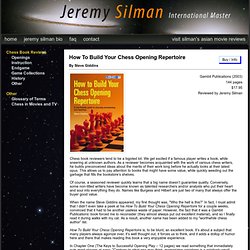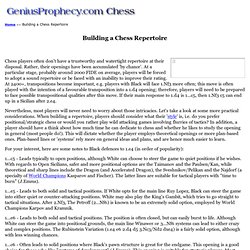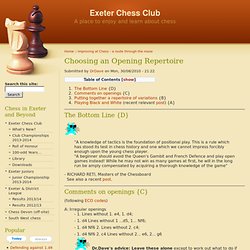

How To Build Your Chess Opening Repertoire. Chess book reviewers tend to be a bigoted lot.

We get excited if a famous player writes a book, while sneering at unknown authors. As a reviewer becomes acquainted with the work of various chess writers, he builds preconceived ideas about the merits of their work long before he actually looks at their latest opus. This allows us to pay attention to books that might have some value, while quickly weeding out the garbage that fills the bookstore’s shelves. Of course, a seasoned reviewer quickly learns that a big name doesn’t guarantee quality. Conversely, some non-titled writers have become known as talented researchers and/or analysts who put their heart and soul into everything they do. When the name Steve Giddins appeared, my first thought was, "Who the hell is this?” How To Build Your Chess Opening Repertoire is, to be blunt, an excellent book. Other chapters prove that the author is anything but lazy, since he anticipates and answers opening-study questions like: Building a Chess Repertoire - GeniusProphecy.com.
Home >> Building a Chess Repertoire Chess players often don't have a trustworthy and watertight repertoire at their disposal.

Rather, their openings have been accumulated 'by chance'. At a particular stage, probably around 2000 FIDE on average, players will be forced to adopt a sound repertoire or be faced with an inability to improve their rating. At 2400+, transpositions become important, e.g. players with Black will face 1.Nf3 more often; this move is often played with the intention of a favourable transposition into a 1.d4 opening; therefore, players will need to be prepared to face possible transpositional qualities after this move. If their main response to 1.d4 is 1...c5, then 1.Nf3 c5 can end up in a Sicilian after 2.e4. Nevertheless, most players will never need to worry about those intricacies. For your interest, here are some notes to Black defences to 1.e4 (in order of popularity): 1...e5 - Leads to both solid and tactical positions.
Study complete games Keeping up-to-date. Www.freewebs.com/camouflage_a/ch_instruction/op_repertoire.pdf. Choosing an Opening Repertoire. The Bottom Line {D} "A knowledge of tactics is the foundation of positional play.

This is a rule which has stood its test in chess history and one which we cannot impress forcibly enough upon the young chess player. "A beginner should avoid the Queen's Gambit and French Defence and play open games instead! While he may not win as many games at first, he will in the long run be amply compensated by acquiring a thorough knowledge of the game" - RICHARD RETI, Masters of the Chessboard See also a recent post. (following ECO codes) A: Irregular openings - 1. . - 1. d4 Lines without 1 ...d5, 1. . . . - 1. d4 Nf6 2. . - 1. d4 Nf6 2. c4 Lines without 2... e6, 2... g6 Dr.Dave's advice: Leave these alone except to work out what to do if someone played them against you. B: Semi-open games.